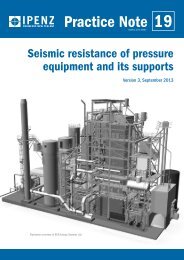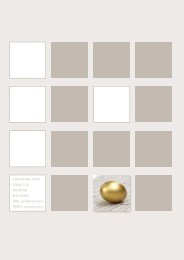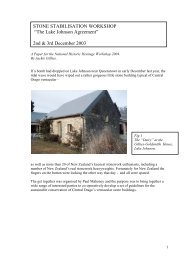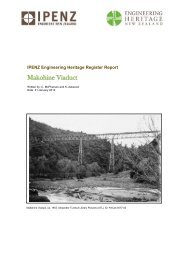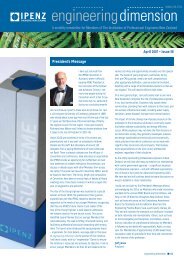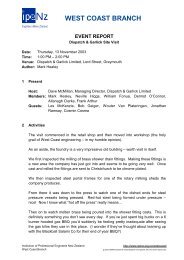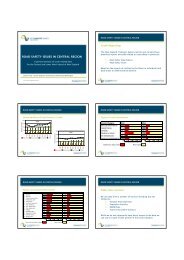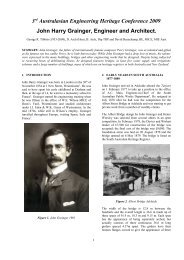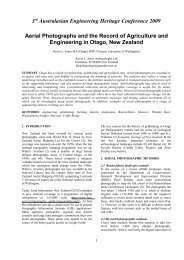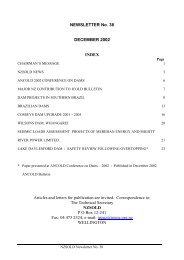Karori Water Supply Dams and Reservoirs Register Report - ipenz
Karori Water Supply Dams and Reservoirs Register Report - ipenz
Karori Water Supply Dams and Reservoirs Register Report - ipenz
Create successful ePaper yourself
Turn your PDF publications into a flip-book with our unique Google optimized e-Paper software.
Historical narrative<br />
In 1865 the seat of New Zeal<strong>and</strong>‟s Government shifted south from Auckl<strong>and</strong> to<br />
Wellington. This was a contributing factor in Wellington‟s rapid population increase by<br />
the end of the century, from 7,460 in 1867 to 49,344. This boost in people led to<br />
overcrowding which, along with poor hygiene <strong>and</strong> a lack of adequate public water<br />
supply <strong>and</strong> sewerage facilities, resulted in a high rate of disease <strong>and</strong> infant mortality. 1<br />
In 1871, Government scientist James Hector referred to the “misery <strong>and</strong> suffering<br />
entailed especially of the children from the presence of intestinal worms” <strong>and</strong><br />
concluded that “no water collected from within the crowded part of the city either from<br />
wells or housetops, is safe or proper for human consumption.” 2 At the time, water<br />
reticulation in Wellington was limited to a few pipes laid by the Government to supply<br />
their own buildings <strong>and</strong> the naval vessels in port. Residential water was “collected<br />
from house-tops into barrels <strong>and</strong> iron tanks, <strong>and</strong> also shallow wells.” 3<br />
Even in 1867 it was recognised that the city‟s water supply was inadequate. Various<br />
plans had been formulated, but nothing came of them because they were “more or<br />
less gr<strong>and</strong> in design, <strong>and</strong> expensive in character.” 4 The chief difficulty was a financial<br />
one. Wellington‟s first town surveyor/engineer, Richard Skeet (1832-1894), developed<br />
a scheme to supply the southern wards of the town with water from the Te Aro (or<br />
Waimapihi) Stream in Polhill‟s Gully (upper Aro Valley), with the Thorndon ward being<br />
supplied from the Kaiwharawhara Stream (or Kaiwarra Stream as it was known by<br />
early European settlers) tapped near Baker‟s cutting. However, the estimated cost<br />
was over £41,000, which was a huge sum <strong>and</strong> beyond local government financial<br />
capacity. Other engineers generally agreed with the scheme, George Aickin (1822-<br />
1882) added that a reasonably deep four acre reservoir would contain enough water<br />
to adequately supply double Wellington‟s population at the time. 5<br />
1 C. Maclean, 'Wellington region - From town to city: 1865–1899', Te Ara - the Encyclopedia of New Zeal<strong>and</strong>, URL:<br />
http://www.TeAra.govt.nz/en/wellington-region/8 (updated 24 November 2009); S. Morrison, History of <strong>Water</strong> <strong>Supply</strong><br />
in the Wellington Region, 1872-1985, Wellington, 1986, p.1<br />
2 A. Mulgan, The City <strong>and</strong> its Strait: Wellington <strong>and</strong> its Province, Wellington, 1939, p.211<br />
3 „<strong>Report</strong> of the Select Committee on the Wellington <strong>Water</strong>works Bill,‟ Appendix to the Journals of the House of<br />
Representatives, 1871, Session I, H-03, p.3. URL: http://www.atojs.natlib.govt.nz/cgi-<br />
bin/atojs?a=d&cl=search&d=AJHR1871-I.2.2.5.3&srpos=1&e=-----1871--10--1------2wellington+waterworks-- <br />
(accessed 26 March 2012). This was stated by Nicholas Marchant, Wellington City Engineer, when he was before<br />
the Select Committee.<br />
4 Wellington Independent, 19 February 1867, p.3<br />
5 Wellington Independent, 16 May 1867, p.5<br />
IPENZ Engineering Heritage <strong>Report</strong> 6<br />
<strong>Karori</strong> <strong>Water</strong> <strong>Supply</strong> <strong>Dams</strong> <strong>and</strong> <strong>Reservoirs</strong>



